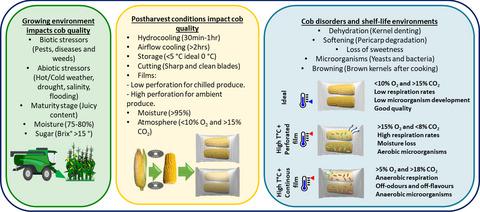当前位置:
X-MOL 学术
›
Food Energy Secur.
›
论文详情
Our official English website, www.x-mol.net, welcomes your
feedback! (Note: you will need to create a separate account there.)
Reducing post-harvest losses and improving quality in sweet corn (Zea mays L.): challenges and solutions for less food waste and improved food security
Food and Energy Security ( IF 4.0 ) Pub Date : 2021-05-04 , DOI: 10.1002/fes3.277 Felipe Becerra‐Sanchez 1, 2 , Gail Taylor 1, 2
Food and Energy Security ( IF 4.0 ) Pub Date : 2021-05-04 , DOI: 10.1002/fes3.277 Felipe Becerra‐Sanchez 1, 2 , Gail Taylor 1, 2
Affiliation

|
Demand for fresh-cut fruit and vegetables is increasing, in the face of global population growth and new interest in plant-based diets. At the same time, year-round supply across the world of popular vegetables means that post-harvest losses, which can be significant, need to be minimized in the face of complex global supply chains and markets. Sweet corn (Zea mays L.) is harvested before physiological maturity when the kernel has high water and sugar concentrations making it a very perishable fresh produce and effective post-harvest handling essential to reduce losses and ensure quality. Taste, aroma and colour are the main customer-appreciated characteristics, hence the most important to preserve. Among the sweet corn post-harvest disorders, loss of sweetness, dehydration, fungal growth and post-cooking browning are the biggest issues impacting sweet corn quality, leading to post-harvest losses. The critical factor driving these losses in sweet corn is temperature. Sweet corn is not a chilling sensitive product and has high sugar content. For this reason, temperatures as close as 0°C and the appropriate use of packaging films to create an altered gas composition with high CO2 and low O2 concentrations can significantly prevent post-harvest decay. The use of low temperatures and effective choice of appropriate packaging films can control sweet corn respiration rates and prevent microorganism growth, subsequently delaying quality loss. This comprehensive review assembles a description of the most customer-appreciated sweet corn characteristics. And it describes the major sweet corn post-harvest challenges and provides a summary of four approaches to improve post-harvest quality in this popular fresh-cut vegetable.
中文翻译:

减少甜玉米(Zea mays L.)的收获后损失和质量:减少食物浪费和改善粮食安全的挑战和解决方案
面对全球人口增长和对植物性饮食的新兴趣,对鲜切水果和蔬菜的需求正在增加。与此同时,全球流行蔬菜的全年供应意味着面对复杂的全球供应链和市场,需要尽量减少收获后损失,这可能是巨大的。甜玉米(Zea maysL.) 在生理成熟前收获,此时籽粒含水量和糖分浓度高,使其成为极易腐烂的新鲜农产品,有效的收获后处理对于减少损失和确保质量至关重要。味道、香气和颜色是客户欣赏的主要特征,因此是最重要的保存特征。在甜玉米收获后失调中,甜味损失、脱水、真菌生长和烹饪后褐变是影响甜玉米品质的最大问题,导致收获后损失。导致甜玉米损失的关键因素是温度。甜玉米不是冷敏感产品,含糖量高。出于这个原因,温度接近 0°C 并适当使用包装薄膜来产生具有高 CO 2的改变的气体成分和低 O 2浓度可以显着防止收获后腐烂。低温的使用和有效选择合适的包装膜可以控制甜玉米的呼吸速率并防止微生物生长,从而延缓质量损失。这篇综合评论汇集了对最受客户赞赏的甜玉米特性的描述。它描述了甜玉米收获后面临的主要挑战,并总结了改善这种受欢迎的鲜切蔬菜收获后质量的四种方法。
更新日期:2021-05-04
中文翻译:

减少甜玉米(Zea mays L.)的收获后损失和质量:减少食物浪费和改善粮食安全的挑战和解决方案
面对全球人口增长和对植物性饮食的新兴趣,对鲜切水果和蔬菜的需求正在增加。与此同时,全球流行蔬菜的全年供应意味着面对复杂的全球供应链和市场,需要尽量减少收获后损失,这可能是巨大的。甜玉米(Zea maysL.) 在生理成熟前收获,此时籽粒含水量和糖分浓度高,使其成为极易腐烂的新鲜农产品,有效的收获后处理对于减少损失和确保质量至关重要。味道、香气和颜色是客户欣赏的主要特征,因此是最重要的保存特征。在甜玉米收获后失调中,甜味损失、脱水、真菌生长和烹饪后褐变是影响甜玉米品质的最大问题,导致收获后损失。导致甜玉米损失的关键因素是温度。甜玉米不是冷敏感产品,含糖量高。出于这个原因,温度接近 0°C 并适当使用包装薄膜来产生具有高 CO 2的改变的气体成分和低 O 2浓度可以显着防止收获后腐烂。低温的使用和有效选择合适的包装膜可以控制甜玉米的呼吸速率并防止微生物生长,从而延缓质量损失。这篇综合评论汇集了对最受客户赞赏的甜玉米特性的描述。它描述了甜玉米收获后面临的主要挑战,并总结了改善这种受欢迎的鲜切蔬菜收获后质量的四种方法。











































 京公网安备 11010802027423号
京公网安备 11010802027423号